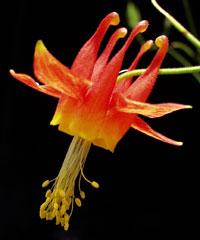
Aquilegia formosa photo courtesy Scott Hodges, UC Santa Barbara
A central goal of biology is to understand the natural genetic variation that is responsible for environmental adaptations, leading to species and higher-order taxa. In order to understand the key features of angiosperm (flowering plant) evolution, we need genomic resources for model organisms from lineages reaching far back toward the base of the evolutionary tree. Aquilegia is a member of the basal-most eudicot clade (Ranunculales) and thus is positioned nearly equidistant between the current model systems Arabidopsis and rice. The genus has been used in numerous ecological and evolutionary studies, including speciation due to pollinator shifts, specialization for soil type, mating system evolution, floral development, and adaptive radiation (adaptation of different forms of organisms to different living conditions). The genus is especially well known for its diversity of floral form associated with different pollinators. In addition, nearly all species can be crossed to produce fertile hybrids, making the genetic dissection of this vast diversity possible.
Having the genome sequence for a species representing such a crucial evolutionary node in angiosperm evolution will greatly enhance our understanding of how plant genomes evolve.
Furthermore, this sequence will lead to a much deeper understanding of the evolution of
morphological, physiological, reproductive, and biochemical innovations found among
angiosperms. In addition, Aquilegia offers the opportunity to understand how plants adapt
to both biotic and abiotic factors in the environment. Such studies will be especially important for understanding how plants adapt, at the molecular level, to a changing environment such
as that resulting from global climate change. For example, A. formosa has a range from Alaska to southern California and spans elevations from sea level to over 10,000 feet, allowing opportunities to study adaptation to different light, temperature, and rainfall extremes. New species of Aquilegia have colonized these different habitats following the major climate changes occurring after the last ice age.
Aquilegia is now poised as an ideal species for whole-genome sequencing. This sequencing will elevate Aquilegia’s status as an attractive model, allowing our collaborators and many newcomers to investigate plant evolution at a new level.
Principal Investigators: Scott A. Hodges (UC Santa Barbara), Justin O. Borevitz (Univ. of Chicago), Elena Kramer (Harvard Univ.), Magnus Nordborg (Univ. of Southern California), and Jeff Tomkins (Clemson Univ.)